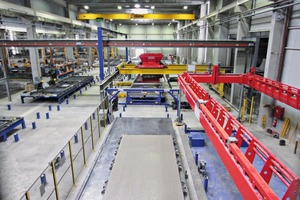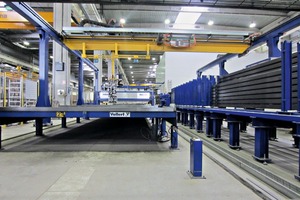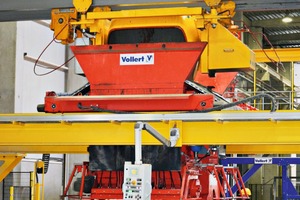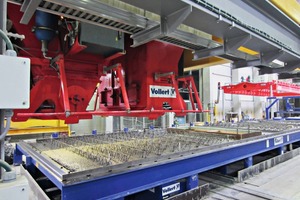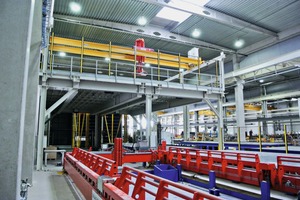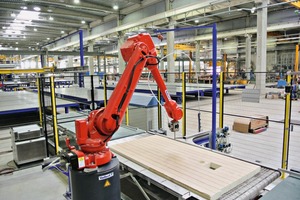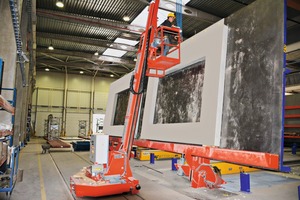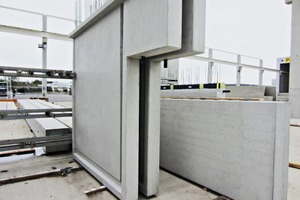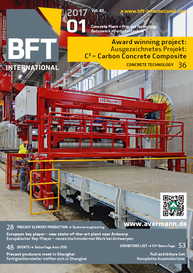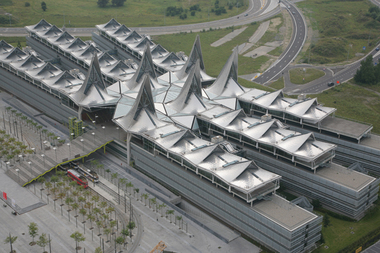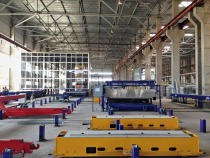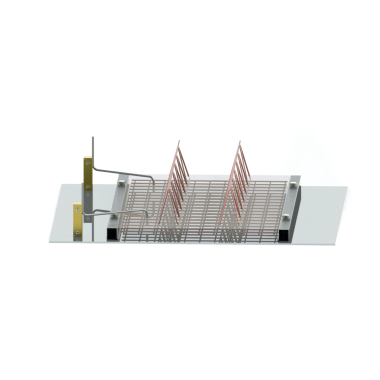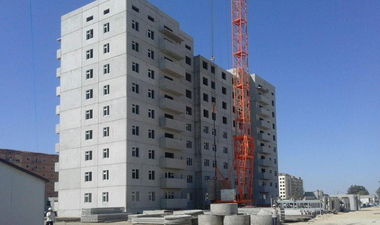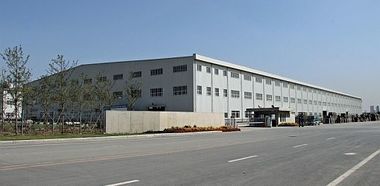Belgian Cordeel Group became a European key player
The Belgian Cordeel Group implements diverse building projects, including exclusive apartment complexes, logistics or industrial parks, modern shopping malls, hospital buildings, schools or infrastructure projects. With the new precast concrete plant in Temse Cordeel has finally become one of the large key players in Europe.
The Cordeel Group relies on turnkey solutions for their building projects throughout Europe. The modern precast architecture makes use of precast concrete components such as solid, double and sandwich elements. A new state-of-the-art precast concrete plant was built in Temse near Antwerp for larger building projects and the further expansion into Eastern Europe above all.
A maximum of plant variability is ensured by several production lines and an intelligent circuit concept. Depending on the order situation and the ongoing building project, the output quantity can be adapted accordingly. “For this new building project we have selected Vollert as an experienced partner with know-how, who not only supplies state-of-the-art plant technology, but also adjusts the technical production processes precisely to these requirements,” explains Ivo de Mulder, Production Manager at the Cordeel Group.
Latest machinery technology and variable production processes
“Here, we manufacturer precast solid and sandwich elements, but also semi-finished elements with high output capacities in parallel to the pallet circuit system. Owing to the limited space a real challenge which was taken into account and resolved already during preliminary planning in close cooperation with the customer and the architects,” explains Philippe Marrié, responsible Senior Sales Manager at Vollert. However, machinery technology and the level of automation are also important factors in modern precast concrete plants. “We permanently work to improve the plant equipment in this regard, to optimize the workflows through new features and to increase the capacities,” Marrié states.
The modern, appealing architecture is a particular trademark of Cordeel projects. Several hundreds of building projects from exclusive housing complexes to large shopping malls and industrial buildings through to hospital and school buildings were realized throughout Europe in the last few years. To meet the high quality standards prevailing nowadays in modern precast construction, it requires flawless wall and floor elements in terms of part geometry and dimensions. “Modern shuttering systems and precise high-performance shuttering robots play a decisive role here. The first working step in the manufacturing process certainly is the most important one likewise in terms of the final quality of the later concrete parts,” Ivo de Mulder says. For this purpose, a Smart Set2 shuttering robot precisely positions the Ratec shuttering profiles onto the prepared circulation pallet with high precision and movement speeds. Plotting of the contours and positioning of the shuttering systems is controlled by CAD/CAM. The robot features four simultaneously moving axles, which in combination with the +/- 180 degree rotating gripper allow for a high degree of repetitive accuracy.
Perfect casting and compacting processes
Apart from the highly automated robot technology used in work preparation, important new innovations became part of the casting and compacting processes, too. The ultra-modern Smart Cast automatic concrete distributor, supplied by a rotary bucket conveyor, ensures homogenous and precise pouring of concrete. The discharge hopper with a maximum capacity of 3 m³ can move longitudinally on the bridge-like concrete distributor as well as laterally, thus achieving a concreting area of up to 3.20 m. A high-performance scanner inspects in advance the position of the shuttering profiles and the inserted reinforcement wire mesh and lattice girders once again. A spiked roller/pusher system is used for concrete spreading.
The discharge volume and the speed of the spiked roller can be perfectly adjusted to different concrete consistencies. Hydraulically operated flat slide valves exclude the respective partial area to be kept free of concrete, such as window openings. The pouring width can be ideally adjusted to various concrete grades using the pusher width adjustment feature. “The twin-bucket concrete spreader is also a real novelty,” explains Philippe Marrié of Vollert. “The concrete distributor features two separate concrete buckets for the first time. In this way, we are able to apply colored architectural concrete along with normal concrete. For cleaning the bucket inside, the concrete distributor moves to a separate washing station, where concrete residues are removed from the twin bucket manually. The tipping bucket of the concrete transport system also moves to this washing station for the fully automated cleaning process.
By storage and retrieval machine into the curing chamber
Compacting the concrete by means of a combined Vario Compact2 shaking-vibration station provides for both a perfect upper shell of the solid concrete parts in architectural concrete quality and compaction of the stronger reinforced supporting shell of double wall and sandwich elements. The low-frequency vibratory movement is generated by four unbalanced drives, thus compacting the concrete. The unbalances are differently synchronized, depending on the weight. This enables an optimum, circular vibrating movement with low noise emissions. It is possible to process much stiffer concrete; in addition, an integrated high-frequency vibrating station is used for concrete compaction. For this purpose, the vibration energy of the eight external vibrators is transferred to the pallet via roller blocks. The floor-based Vario Store storage and retrieval machine puts the semi-finished concrete elements into the curing chamber for the curing process. The fully insulated Vario Cure curing chamber consists of three encased rack towers with 13 pallet trays each and is equipped with a special heating system.
To obtain a high architectural concrete quality, the solid concrete elements are removed from the rack after a short pre-curing time and carried to a workstation for smoothing above. The power trowelling system featuring a bridge design moves in longitudinal and lateral direction and allows for smooth surfaces. This is provided by an electrically driven smoothing head with adjustable vanes and variable rotational speeds. If the desired surface quality has been achieved, the concrete part is returned to the curing chamber for continuing the hardening process. This working step can be done several times. As soon as the final curing time has been reached, the pallet is moved to the demolding station via a run-off tray.
Optimized workflows in double and sandwich wall production
If double or sandwich wall elements are produced, the storage and retrieval machine takes the circulation pallet out of the curing chamber soon after hardening of the first shell and transfers the pallet to the stationary pallet turning equipment via the transport line. The hardened upper shell is clamped to the pallets by means of hydraulic tensioning arms. At first hydraulic cylinders lift the turning frame for the following turning process. The forces of gravity prevailing during the turning motion are taken up by a longitudinal stop, thus ensuring a safe turning process and preventing the precast elements from slipping to the side. Permanently mounted and manually adjustable spacers enable producing different wall thicknesses. As soon as the first shell has been turned by 180 degrees, the bottom shell is moved under the turning equipment. This is lowering and connects the two shells with each other – creating the wall element.
Afterwards, the semi-finished element is compacted once again by vibrating the fresh concrete of the bottom shell. Synchronous vibration without any relative movement of the first to the second shell ensures high product quality and no segregation of the concrete near the reinforcement.
Cost-effective insulation material preparation
A cost-effective preparation of the insulation material is also crucial for the production of precast sandwich elements, so as to able to manufacture large production outputs of high-quality walls even in tightly organized process and short time frames. For this reason, the Iso-Matic 2.0 was selected for the new Cordeel plant; this workstation allows preparing insulation material in any geometric shape desired (bored circles, diagonals, waves, etc.) with high precision in an automated process. The dimensions of the parts are read from the existing CAD data. The Iso-Matic generates the required cut from this information fully automatically. A 6-axle cutting robot performs the cut into the insulation material in the desired geometrical shape with high precision, using a water jet at 4.000 bar and axle speeds of 175 up to 360 degrees/s. Additional boring or milling tools for block-outs of the embedded parts or sanitary and electric installations are no longer required. Customer-specific basic settings such as insulating panel thickness, clearance and type of the connection anchors and others can be integrated easily.
The Vario Tilt high-performance tilting station carries out the vertical lifting of solid concrete and semi-finished elements, applying a maximum angle of 80o. A hydraulically moving supporting beam drives against the fixed edge formwork, thus preventing the concrete elements from sliding during the tilting process. For the lifting process, first the lifting anchor is fixed to the wall element by means of a moving lifting cage, providing for more occupational safety compared to a conventional elevator.
Perfectly controlled, economically evaluated
Technology that is state-of-the-art and perfectly matching the level of automation are the features characterizing this plant concept. “In particular, the flexible working processes allow us to manufacture a wide range of precast concrete elements for multi-story residential buildings, shopping malls or hospitals. The entire plant configuration as well as all storage processes are controlled centrally with the aid of a modern Unitechnik master computer system,” states Philippe Marrié of Vollert. A visualization computer actuates the individual workstations, takes over pallet configuration as well as routing of the pallet transport, and manages the sequences of removal from storage and curing times.
“With the new precast concrete plant in Temse, we feel perfectly prepared for the expansion of our construction activities throughout Europe. We have actually become a real key player and are looking forward to the next major building projects,” sums up Ivo de Mulder of the Cordeel Group.

